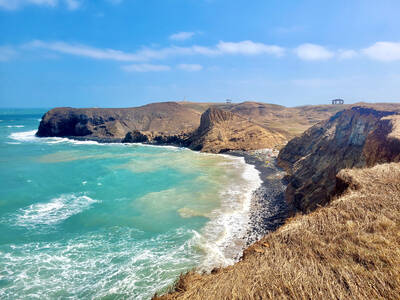Charles Darwin’s ideas on evolution changed the face of science forever, but he was a modest, shy man who preferred to stay at home with his work and family than revel in celebrity.
“I have no great quickness of apprehension or wit,” he once wrote. “My power to follow a long abstract train of thought is very limited ... my memory is extensive but hazy.”
Darwin was born on Feb. 12 1809 in Shrewsbury, western England, to a wealthy family — his father was a doctor, one grandfather, Erasmus Darwin, was a noted natural philosopher and another, Josiah Wedgwood, set up a famous pottery.
He was a reluctant student. After school, he went to Edinburgh University to study medicine like his grandfather, father and brother but was bored by lectures and horrified by watching surgery without anesthetic.
He started studying natural history in his own time, taking long walks on beaches near Edinburgh, where he hunted for shells and watched wildlife.
Darwin quit medicine and his furious father sent him to Cambridge University where he studied to be a clergyman, but it was the same story: he was more interested in collecting beetles than hitting the books.
Then his life — and, in no small measure, the history of the world — was turned on its head.
One of his professors recommended him to Robert FitzRoy, captain of HMS Beagle, who wanted a companion for a two-year, round-the-world surveying mission.
The Beagle set sail in 1831, when Darwin was aged 22. The voyage extended to five years, taking in places like Brazil, the Galapagos Islands, Tahiti, New Zealand and Australia.
Despite chronic seasickness, the young man was thrilled.
“My mind has been, since leaving England, in a perfect hurricane of delight and astonishment,” he wrote.
Darwin collected a mountain of flora and fauna specimens, all of which were carefully tagged, and resolved to write a book on his discoveries when he returned home.
The Beagle docked in Britain in 1836 and Darwin, who never ventured abroad again, buried himself in work.
He published Journal of Researches Into the Geology and Natural History of the Various Countries Visited by HMS Beagle, the book which made him famous, in 1839.
But stress began to take its toll and the ill health which dogged him for the rest of his life took hold.
He agonized over whether to get married to ease his anxiety and drew up a list of pros (“constant companion ... better than a dog, anyhow”) and cons (“terrible loss of time”) before concluding he must wed.
He married his cousin Emma Wedgwood in 1839 after a quick courtship. Theirs was a contented union that produced 10 children.
After his Beagle voyage, Darwin became more and more convinced that species were not static but evolved, and that this process was molded by individuals who had adapted best to their habitat.
He was finally forced to make his ideas public after another naturalist, Alfred Russel Wallace, wrote to him in 1858 outlining ideas similar to his own.
Darwin was stunned, but it was decided that the two men’s theories should be made public side-by-side at a London scientific society.
He then condensed his theories into On the Origin of Species, published in 1859.
The book was a massive popular success, prompting widespread debate, angry opposition from theologians and references to Darwin in a slew of cartoons, songs and advertisements.
His fame grew further with The Descent of Man in 1871. It argued that Man and ape shared a common ancestor and expounded on the theory of sexual selection — that certain traits such as strength and good looks improve an individual’s success at mating.
Darwin was endowed with extraordinary patience and diligence, as well as a mental agility enabling him to see both fine detail and the big picture.
But he also had the luck to have independent wealth, which gave him the time to research and reflect, and to be living in Victorian England, within a train ride from academies and institutions in London, then the world’s scientific hub.
“He was a quintessential British amateur in the best possible sense,” said German historian Wilfried Rogasch. “He had the means and the time and the intellectual capacity to follow what was going on.”
Darwin died in 1882, aged 73. Typically, he wanted to be buried near his beloved home, Down House in Kent, southeast of London, but his contemporaries campaigned for a grander send-off.
His funeral was at London’s Westminster Abbey, also his final resting place.

Last week, on the heels of the recall election that turned out so badly for Taiwan, came the news that US President Donald Trump had blocked the transit of President William Lai (賴清德) through the US on his way to Latin America. A few days later the international media reported that in June a scheduled visit by Minister of National Defense Wellington Koo (顧立雄) for high level meetings was canceled by the US after China’s President Xi Jinping (習近平) asked Trump to curb US engagement with Taiwan during a June phone call. The cancellation of Lai’s transit was a gaudy

From Godzilla’s fiery atomic breath to post-apocalyptic anime and harrowing depictions of radiation sickness, the influence of the nuclear bombings of Hiroshima and Nagasaki runs deep in Japanese popular culture. In the 80 years since the World War II attacks, stories of destruction and mutation have been fused with fears around natural disasters and, more recently, the Fukushima crisis. Classic manga and anime series Astro Boy is called “Mighty Atom” in Japanese, while city-leveling explosions loom large in other titles such as Akira, Neon Genesis Evangelion and Attack on Titan. “Living through tremendous pain” and overcoming trauma is a recurrent theme in Japan’s

As last month dawned, the Democratic Progressive Party (DPP) was in a good position. The recall campaigns had strong momentum, polling showed many Chinese Nationalist Party (KMT) lawmakers at risk of recall and even the KMT was bracing for losing seats while facing a tsunami of voter fraud investigations. Polling pointed to some of the recalls being a lock for victory. Though in most districts the majority was against recalling their lawmaker, among voters “definitely” planning to vote, there were double-digit margins in favor of recall in at least five districts, with three districts near or above 20 percent in

The great number of islands that make up the Penghu archipelago make it a fascinating place to come back and explore again and again. On your next trip to Penghu, why not get off the beaten path and explore a lesser-traveled outlying island? Jibei Island (吉貝嶼) in Baisha Township (白沙鄉) is a popular destination for its long white sand beach and water activities. However, three other permanently inhabited islands in the township put a unique spin on the traditional Penghu charm, making them great destinations for the curious tourist: Yuanbeiyu (員貝嶼), Niaoyu (鳥嶼) and Dacangyu (大倉嶼). YUANBEIYU Citou Wharf (岐頭碼頭) connects the mainland